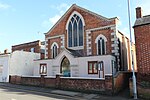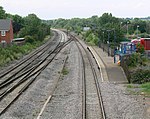Cossington Gate railway station
Disused railway stations in LeicestershireEast Midlands railway station stubsFormer Midland Railway stationsPages with no open date in Infobox stationRailway stations in Great Britain closed in 1873 ... and 2 more
Railway stations in Great Britain opened in 1845Use British English from March 2015
Cossington Gate railway station was a small station serving Cossington village in Leicestershire. It served the Midland Counties Railway, built in 1840, which shortly joined the North Midland Railway and the Birmingham and Derby Junction Railway to form the Midland Railway.The station was associated with a level crossing - hence Cossington Gate. Station buildings were provided in 1846 looked after by the crossing keeper. However, when the lines were quadrupled in 1873, the crossing was replaced by a bridge and the station closed.
Excerpt from the Wikipedia article Cossington Gate railway station (License: CC BY-SA 3.0, Authors).Cossington Gate railway station
Back Lane, Charnwood
Geographical coordinates (GPS) Address Nearby Places Show on map
Geographical coordinates (GPS)
| Latitude | Longitude |
|---|---|
| N 52.7172 ° | E -1.0978 ° |
Address
Back Lane
Back Lane
LE7 4SE Charnwood
England, United Kingdom
Open on Google Maps











